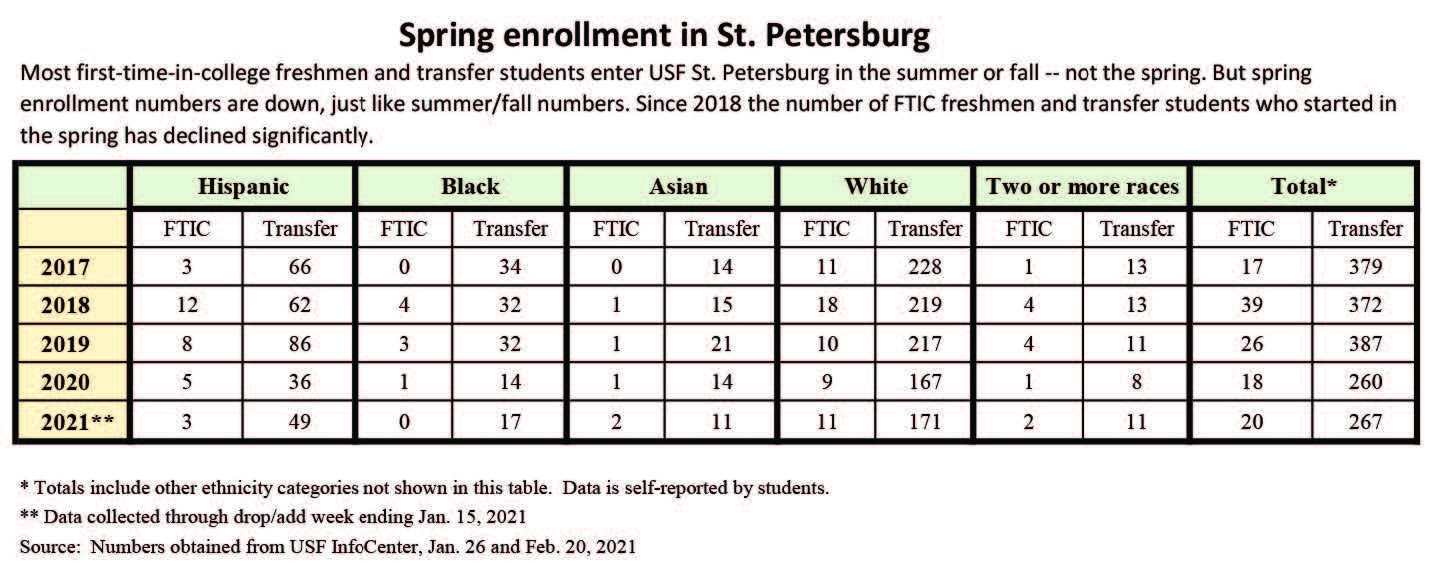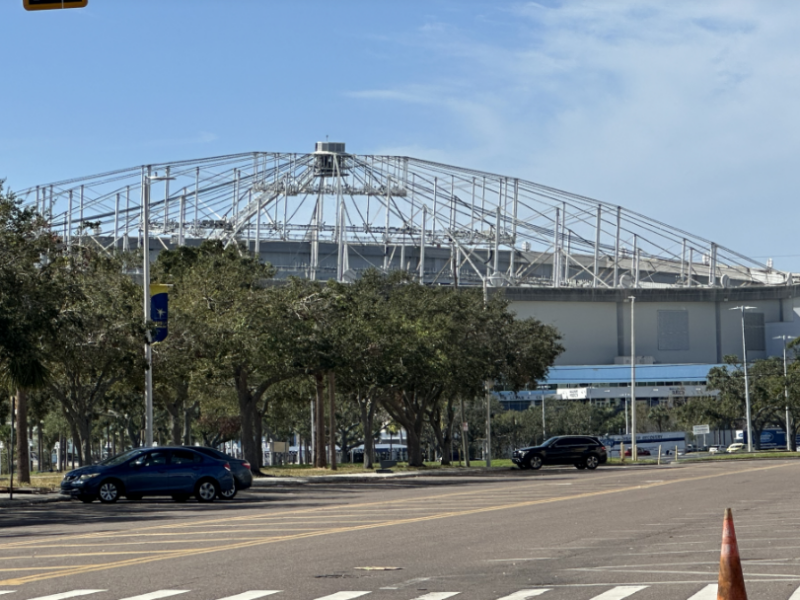Courtesy of Matt McCann
By Nancy McCann and Sophie Ojdanic
Spring enrollment of new students at the St. Petersburg campus hasn’t sprung, as some campus leaders had once hoped.
Instead, enrollment of first-time-in-college (FTIC) freshmen and transfer students starting in the spring semester has dropped significantly since 2018.
The number of new freshmen starting in the spring went from 39 in 2018 to 20 this semester, and the transfer student head count fell from 372 to 267 over the same time period.
Enrollment in spring 2020 – which wouldn’t have been affected by the pandemic – was also down from recent years.
The spring numbers are a small piece of what has become an alarming enrollment trend in St. Petersburg.
Since the campus began rapidly raising its admission standards in 2018 to align with the Tampa campus in preparation of consolidation, the number of summer and fall FTIC students in St. Petersburg has plummeted. It hit 386 in 2020 — down from 647 in 2016.
Alarmed, two powerful legislators put pressure on USF’s leadership in October to agree to “a strong goal of 650 (FTIC) students” in St. Petersburg for the combined summer and fall semesters.
University administrators now say they are “cautiously optimistic” that St. Petersburg will reach that goal.
One is Laura Zuppo, St. Petersburg’s interim assistant vice chancellor of enrollment, planning and management.
“Given the fact that we’re in a COVID environment, given the economic uncertainties . . . if we can hit the 650 or even 600, I think that would be outstanding,” Zuppo told The Crow’s Nest last month. “We were really given a challenging goal to reach.”
Aiming for higher numbers
USF’s dean of admissions, Glen Besterfield, said he is also “cautiously optimistic” about reaching the goal of 650 FTIC students in the combined summer and fall semesters.
He told a Board of Trustees committee last week that he needs a little more time – even though the number of students admitted so far at the three campuses is already up from last year’s total.
“For St. Pete, we are up 82 percent in admits. For black admits to St. Pete we’re up 117 percent,” Besterfield said. “Right now, if I shut down admissions today, based upon past yield, we would yield 490 students to St. Pete enrolled.”
The term “yield” means the percentage of students who enroll after being offered admission to a university.
“Give me another three weeks – we’re still enrolling admissions – I should be able to target 650 enrolled students, assuming that yield remains consistent,” Besterfield said.
In an interview with The Crow’s Nest, Besterfield described how the admissions staff is driving up the numbers.
He said he has “flexed” admissions requirements because of the pandemic.
“I was able to admit students this year that I normally would not admit,” Besterfield said. “But I think we’re doing the right thing for the future — putting more emphasis on GPA.”
He said he is also admitting students with lower test scores this year but declined to disclose those numbers for publication.
Additionally, Besterfield said the university typically stops admitting in March for the summer and fall semesters, but “I think I’ll be rolling through April here.”
“I’m really kind of shooting for the moon and making sure I over-admit instead of under-admit because I really have no idea how this class is going to yield,” he said.
Some students who applied after the priority deadline (Jan. 6), he said, are being redirected to St. Petersburg regardless of campus preferences to help reach the 650 FTIC target.
The students can change home campuses after the first semester.
Besterfield said there have been several complaints about redirecting students to St. Petersburg, but “only one has made it to me.”
He said he believes by communicating with that student, an understanding had been reached.
After explaining to the student that she can still be in the Judy Genshaft Honors College, sending a link to the St. Petersburg virtual tour, and mentioning some highlights of the campus, Besterfield said, she seemed “OK” with starting at the smaller campus.
“I put in my email that St. Pete is a bayfront campus (with) potentially smaller class sizes and a more intimate environment,” Besterfield said.
He said he mentioned the Mahaffey Theatre, the Dali Museum and the downtown arts district.
“At the end of the day, people are just reasonable when you talk to them,” he said. “Potentially are some students not going to enroll? Yes, I understand that. That’s their conscious decision.”
Regional Chancellor Martin Tadlock said that students redirected to the St. Petersburg campus for their first semester at USF might find it to be a better fit for their learning style, and a “much more ideal location for them than they ever knew.”
In his latest weekly update to faculty and staff, Tadlock is also optimistic about enrollment for summer and fall. (See his update below.)
Although the total number of transfer students entering St. Petersburg has dropped significantly after remaining largely unchanged for years, Besterfield predicted those numbers will soon tick up.
The number of students transferring to the St. Petersburg campus in the summer semester fell from 186 in 2019 to 95 in 2020; in the fall semester, from 594 to 415 for the same years; and in the spring semester, from 387 in 2019 to 267 in 2021.
Besterfield said he implemented new “robust” transfer requirements in selected majors, effective in fall 2019 for the Tampa campus and fall 2020 for the St. Petersburg campus.
This left some students with additional classes to take before they can transfer to USF.
“If a (transfer) student wanted to major in finance in St. Pete, up until fall ’20 all they had to have . . . was a 2.5 (GPA), I think it was,” he said. “Now, the students have to complete prerequisites.
“So, yeah, it hurts, but what will happen – and we’ve already seen it in Tampa – the students are coming back. They’re just delaying entry for a semester or two until they get their prerequisites.”
The spring gateway
Three years ago, when plans for consolidating the three USF campuses surfaced, one of the first fears in the St. Petersburg community was that enrollment numbers at its campus would suffer.
The concern was that higher admissions standards would shut out some of the students who had thrived at USF St. Petersburg despite having lower high school GPAs.
As enrollment of new freshmen in St. Petersburg plummeted, as feared, some administrators thought students should focus on other entry points to USF St. Petersburg.
One of those gateways, they said, would be starting college in the spring semester, when it has traditionally been easier to gain admittance with lower high school GPAs and achievement test scores.
In 2018, Serge Desir, then-director of St. Petersburg’s undergraduate admissions, said the reason for having a lower student profile in the spring semester was to make the campus accessible to some good students who do not meet the higher fall requirements.
The student profile each semester is the average high school GPA and average test score of all new freshmen admitted – one of the first things students applying to college want to know.
Desir had said the spring 2019 St. Petersburg student profile was targeted for “an average GPA from 3.3 to 3.5 and 1100 to 1150 for the SAT,” while the Tampa Bay Times reported that Tampa’s student profile for the 2018 fall semester was a GPA above 4.0 and 1300 for the SAT score.
Tadlock would also cite admittance in the spring as one of the alternative pathways to USF St. Petersburg as it became harder to get accepted for the summer and fall semesters.
He is no longer stressing this option, telling The Crow’s Nest that low spring numbers are partly due to “the archaic culture” of thinking a student must immediately start college in the fall after graduating from high school.
Until that traditional belief changes, Tadlock said, there won’t be a big increase in the number of students applying for entry in the spring semester.
Jake Diaz, St. Petersburg’s dean of students, agrees that there is “a prevailing narrative out there” for starting college in the fall semester.
“I think there’s a strong desire to feel connection. And I think starting with a larger group of peers (in the fall). . . . fosters that sense of community,” Diaz told The Crow’s Nest.
Besterfield said he thinks it’s “better for the student to go one year to community college . . .take the right courses . . . and then come in the fall semester with the next incoming class.”
The way we were
Tadlock said “it’s absolutely essential” that the campus returns to “the enrollment that we had prior to consolidation as a starting point to move forward, not as an end goal.”
“This is a prime location to expand,” he said. “And getting back to where we were is just the beginning.”
It was Sen. Jeff Brandes, R- St. Petersburg, and Rep. Chris Sprowls, R-Palm Harbor — the speaker of the Florida House of Representatives — who intervened to drive enrollment back up to 650 new freshmen in the summer and fall.
Brandes, whose assertive style has earned him the nickname “Senator Disruptor,” recently told The Crow’s Nest he is leaving no room for error.
“The 650 was a commitment and we fully expect the administration to live up to this commitment,” Brandes said.
And if that doesn’t happen?
“As with anybody who doesn’t live up to a commitment, you evaluate the relationship,” he said.
On Feb. 16, Brandes filed legislation that would establish an admissions office at the St. Petersburg campus “separate from the University of South Florida.”
If Brandes’ bill becomes law, control of St. Petersburg’s admission process that was transferred to Tampa under consolidation would be returned to the campus.
“A stronger fall FTIC class”
Here’s what Martin Tadlock said in his Feb. 25 Regional Chancellor’s Weekly Update about summer and fall enrollment at the St. Petersburg campus.
We are “cautiously optimistic” about enrollment for the upcoming summer/fall. USF Dean of Admissions Glen Besterfield anticipates fall FTIC enrollment to come in stronger than predicted, with fall FTICs at approximately 370 (versus previously anticipated 280) and summer FTICS at approximately 280 (versus 370 as previously anticipated). These shifts are a result of the applicant pool and how it has trended to date. Further, this will likely result in a stronger fall FTIC class.
- Summer FTIC: 660 applications (up 6% from last year); 514 admits (up 36%); Goal: 370
- Summer Transfer: 255 applications (up 13% from last year); 102 admits (up 59%) Goal: 140
- Fall FTIC: 2035 applications (up 38% from last year 1473 v. 2035); 910 admits (up 87%); Goal: 280
- Fall Transfer: 296 applications (down 1% from last year); 100 admits (up 61%) Goal: 530



